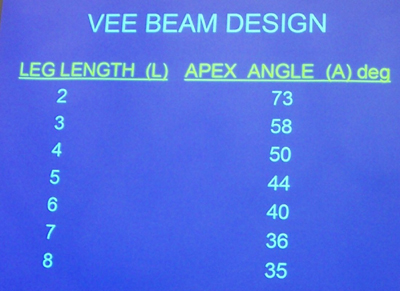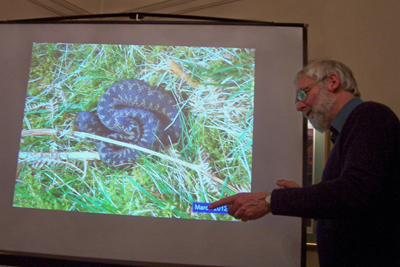
Malcolm Hamilton GM3TAL
At the meeting of the Lothians Radio Society on 13th February 2013 Malcolm Hamilton GM3TAL, who is a keen HF DXer and contester, presented some reasons for using wire antennas and described practical examples of antennas he has tried out in a variety of different locations. Constructional hints and tips were offered about how to optimise performance to achieve the desired objective whether this is working DX or local stations.
The reasons include: no space / no money / neighbours / wife! Malcolm has tried most types of wire antennas: dipoles: sloping, low horizontal and trap; delta loops; Vee-beams; inverted-Ls; Beveridges and described his results with each of them. In general he prefers optimized single-band antennas of simple, inexpensive construction, not needing an antenna tuning unit (ATU).
- Sloping Dipole: 16SWG wire or Flexweave cable, using cable ties as end-insulators. Low end not less than lambda/6 above ground. Very good for DX with low-angle radiation in the direction of the slope.
- Low Dipole: often difficult to get minimum of a half-wavelength height. High-angle radiation (NVIS) is good on 5MHz and 3.5MHz. Impedance is about 40 ohms, allowing use of 50 ohm coax. Malcolm played a recording of a QSO with G3SHK in Salisbury at sunrise with the signal strength rising rapidly.
- Trap Dipole: home-made 5400 kHz traps made from coax cable wound onto PVC pipe.
- Delta Loop for 28MHz: full-wave using covered Flexweave at 8ft or 48ft. Impedance is 120 ohms requiring a quarter-wave Q-section of RG11 coax (50 ohm). EZNEC modelling by GM3ZBE (now SK) indicated good low-angle radiation which permitted Malcolm to hear 9L1NH (G3RWF) in Malawi.
- Vee-Beam: the terminated version has 800ohms impedance, requiring balanced feeder ideally at 40ft up and a balun in the shack. The un-terminated version allows propagation on both paths! An impedance transformer from 800 ohms to 50 ohms requires a grounding wire to drain off static. This antenna was used successfully on Malcolm’s 7Q7MH DXpedition to Sierra Leone where bamboos provided good supports. A Vee-Beam for 70MHz (2 x 10 wavelengths) worked very well in Dunfermline during VHF NFD but was so sharp that two were needed for QSOs with London and Devon!
- Beveridge: Malcolm, along with Bernie GM4WZG, who attended the presentation, constructed a full-wave Beveridge 520ft long for use on receive in the ARRL 160m contest.
- For 160m transmit, a 500ft Inverted-L was used; this gave much higher noise on receive.
Constructional Hints and Tips. Malcolm concluded his very well-received talk by showing the various construction al materials he uses: 16SWG wire, Flexweave cable, cable-ties, nylon cord, tent pegs, bamboo poles, PVC plumbing pipe and fittings (for traps) and marine cord and pulleys from a yacht shop. He recommended Noalux cream for providing conductivity between aluminium mast sections. The use of an impedance meter such as the MFJ-259 is essential when doing experimental work. As a cautionary tale he showed a nice plastic centre insulator for a dipole, which went open-circuit after six months exposure to the (Scottish) elements!

A modest commercial wire antenna farm.

Malcolm’s Delta-Loop antenna for 28MHz.

Malcolm demonstrating how the radiation patterns of two long wires
blend together when fed as a Vee-beam.

The Apex Angle of a Vee-Beam narrows as the leg length increases.

Malcolm’s entire kit, including wire antennas, for his DXpedition to Sierra Leone as 7Q7MH

Bamboo poles proved excellent supports for Malcolm’s wire antennas.

Summary of Malcolm’s DXpedition results as 7Q7MH

Three 10-lambda long wires switched in pairs provided the necessary two Vee-Beams
to work both London and Devon on 70MHz.

EZNEC modelling by I4EWH of a 1-wavelength Beveridge antenna for 160m receive.

This adder was a hazard encountered when operating in Argyll!

(No additional caption required)!

A yacht store provided very suitable cord and components for supporting wire antennas.

Malcolm’s cautionary tale was that this plastic centre-insulator lasted only six months
in the Scottish climate before developing an open circuit!

Malcolm recommended these books on wire antennas.

Check out the head-mounted antennas!

A selection of wire and components for wire antennas.

After his most interesting talk, Malcolm was thanked by LRS President, Andy Sinclair MM0FMF (L)
